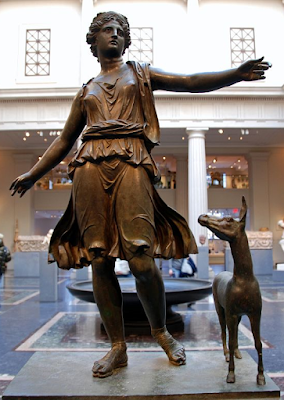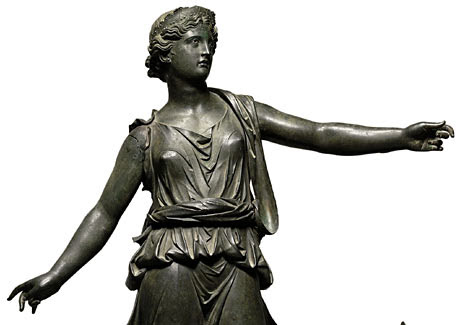 | Dated to 330 BC, the Boxer at Rest is a sculpture of a sitting nude boxer at rest, still wearing his caestus, a type of leather hand-wrap, in the National Museum of Rome.
|
 | “Portrait of Seuthes III” (310-300 B.C.), Greek. Bronze, copper, calcite, alabaster, and glass. Seuthes III was a ruler of the Odrysian kingdom of Thrace from 331 BC to ca. 300 BC. This bronze was found in his tomb. “The Medici Riccardi Horse” About 350 B.C. Italian Bronze and gold. |  |
 | The bronze "Chimera of Arezzo" is one of the best known examples of the art of the Etruscans. It was found in Arezzo, an ancient Etruscan and Roman city in Tuscany, in 1553. Inscribed on its right foreleg is an inscription, TINSCVIL, showing that the bronze was a votive object dedicated to the supreme Etruscan god of day, Tin or Tinia. The statue is thought to have been made around 400 BC. |  |
 | The over-lifesize "Dancing Satyr" of Mazara del Vallo is a Greek bronze statue recovered from the sea floor at a depth of 500m (1600 ft.) off the southwestern coast of Sicily in 1998. The satyr is depicted in mid-leap, head thrown back ecstatically and back arched, his hair swinging with the movement of his head. The figure is highly refined; the whites of his eyes are inlays of white alabaster. |  |
 | Artemis and the Stag is an early Roman Imperial or Hellenistic bronze sculpture of the ancient Greek goddess Artemis. In June 2007 the statue fetched $28.6 million at auction, the highest sale price of any sculpture at the time. The statue depicts Artemis, the Greek goddess of hunting and wild animals. She stands in a pose that suggests she has just released an arrow from her bow. At some point in its history, the bow was separated from the sculpture and was lost. |  |
 | Alexander the Great on Horseback, 100-1 B.C., bronze and silver. Victorious Athlete, "The Getty Bronze" 300-100 B.C. |  |
 Statue of Athene (“The Peiraeus Athena”). Bronze. 340—330 BCE |  The Artemesium Zeus The Artemesium Zeus The horses of St Mark's Basilica. 2nd or 3rd century AD. The horses of St Mark's Basilica. 2nd or 3rd century AD. |  The Riace Bronzes (The Riace Warriors) Around 460 BC. The Riace Bronzes (The Riace Warriors) Around 460 BC. |



No comments:
Post a Comment